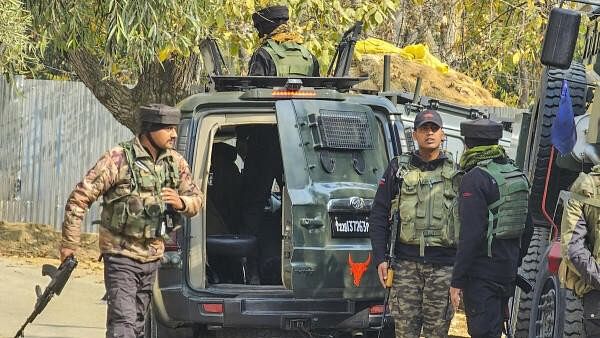
Security personnel during an encounter with terrorists at Sagipora area of Sopore, in Baramulla district, J&K, Friday, Nov. 8, 2024.
Credit: PTI Photo
Srinagar: After more than two years of relative peace, Kashmir has once again descended into violence with targeted attacks on civilians and frequent clashes between militants and security forces on surge.
In recent weeks, there has been a rise in the frequency and intensity of attacks across the valley, with militants targeting both security personnel and civilians.
From a grenade attack at the bustling Sunday market in Srinagar and an ambush on a military convoy near Gulmarg ski-resort in north Kashmir, to the killing of six construction workers and a doctor in the biggest targeted attack at a camp of a private company in central Kashmir’s Ganderbal district, violence has become a routine affair, reminiscent of the darker days that the region had hoped to leave behind.
The latest surge in violence is particularly significant given the relative calm that had prevailed in the valley since the abrogation of Article 370 in 2019. Especially after early 2023, the security apparatus had largely succeeded in curbing militant activities. Official figures indicate that between 2021 and 2023, security forces neutralized 443 militants, including 127 foreign ones.
This period of reduced violence also brought about a noticeable shift in the attitudes of Kashmiri youth. The growing sense of normalcy was reflected in their increased participation in the democratic process, with high voter turnout in both the Lok Sabha and the Assembly elections in the Union Territory.
Though violence is not new to the valley, recent trend has worried experts as the centre of militant activity seems to be shifting from south Kashmir districts of Anantnag, Kulgam, Pulwama and Shopian to the relatively less-affected central and north Kashmir districts of Srinagar, Ganderbal and Baramulla.
“The recent spate of attacks and encounters suggest that terror activity has spread deeper into the valley. One reason could be the high concentration of security forces and intelligence activity in south Kashmir, which may have forced militants to move towards Srinagar and Baramulla,” a senior police officer told DH.
He said the intelligence network in central Kashmir is less developed than in South Kashmir due to its relative calm and fewer incidents of violence since 2014. “Containing this bout of terrorist violence is imperative, as its persistence can undo the gains made post-August 2019 in the region,” the officer added.
From 2010 to 2020, the epicenter of militancy in Kashmir shifted to the southern parts of the valley, while the central and northern regions remained relatively calm. Following the revocation of Article 370 in August 2019, security forces intensified their focus on dismantling the militant strongholds in South Kashmir, which had become a major hub for terrorism.
With a strengthened security grid, the forces largely succeeded in breaking down the terror infrastructure in the region. These efforts led to a significant decline in local recruitment into militant groups. In 2022, only 100 local youths joined militant organizations, and this number dropped further to just 25 in 2023.
Currently, security agencies estimate that around 110 foreign militants and 27 local militants are active in Jammu and Kashmir.
It seems militants now want to make Srinagar and other relatively calmer areas of the valley the new center of violence.